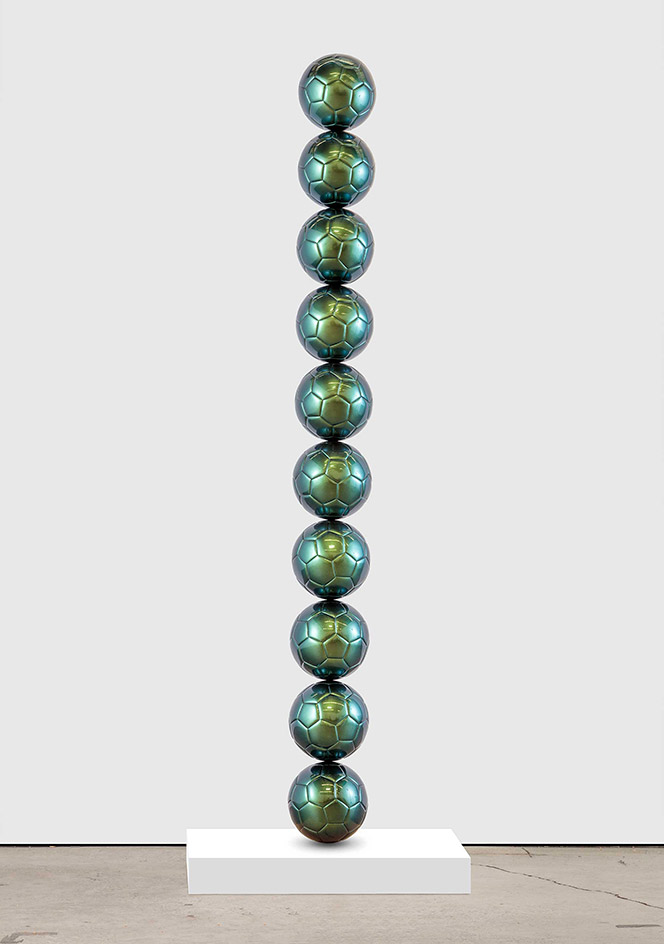The art of the beautiful game: football moves off pitch and into the museum

Football has many guises. It is a pastime where schoolboys scrape knees in a courtyard; a tear-jerking symbol of national pride; a multi-billion dollar industry with corporate interest; a global franchise with a zealot-like devotion to the athletes – the list goes on. And yet, no matter what form it takes, the sport still embodies a common vocabulary, uniting people from different cultures and nations.
The show ‘The World’s Game: Fútbol and Contemporary Art’, on view at Pérez Art Museum Miami (PAMM) until 2 September, explores football’s many definitions. Overlapping with the 2018 FIFA World Cup in Russia, the exhibition investigates soccer’s role in art through the works – including photography, sculpture, and painting – of more than 30 artists such as Andy Warhol, Maria Lassnig, and Antoni Muntadas.

Samuel Eto’o, 2010, by Kehinde Wiley, oil on canvas.
Warhol’s 1978 portrait of the Brazilian football star Pelé, part of the artist’s Athletes series, considers the God-like status that many athletes assume. Brazilian artist and photographer Vik Muniz similarly depicts the sporting hero in his 2003 piece Edson (Pelé) from Pictures of Magazines, grinning next to Warhol’s. The depiction of athletes as adored and influential figures of pop culture is compounded by American painter Kehinde Wiley’s portrait of renowned Cameroonian player Samuel Eto’o, who won the African Player of the Year award a record of four times. Eto’o stands in his portrait (above) powerful, radiating, larger than life.
Other artists question to what extent football can be considered a ‘game’. Taryn Simon’s large-scale photograph from her series Paperwork and the Will of Capital (2015) focuses on the floral centrepiece that adorned the FIFA negotiating table when the sporting organisation agreed to outlaw third-party ownership of economic rights of football players. Paul Pfeiffer, on the other hand, injects amusing absurdity into the exhibition with his video Caryatid (2003), which features isolated footage of players ‘diving’ in attempts to gain penalties. The sport is stripped of solemnity; a quality more noticeable when gone.
The exhibition’s variety competes with the diverse definitions of football itself. It investigates how art can intersect with sport, two categories that can sometimes feel diametrically opposed. PAMM director Franklin Sirmans notes the exhibition ‘presents the art of the game as much as the game of art’.

Endless Column III, 2017, by Hank Willis Thomas, fibreglass, chameleon auto paint finish. Courtesy of the artist and Ben Brown Fine Arts, London. © Hank Willis Thomas.

Installation view of ‘The World’s Game: Fútbol and Contemporary Art’ at Pérez Art Museum Miami.

El futbolista delicado de la tricolor, 2005, by Roberto Guerrero, digital print on polystyrene.

Installation view of ‘The World’s Game: Fútbol and Contemporary Art’ at Pérez Art Museum Miami.
INFORMATION
‘The World’s Game: Fútbol and Contemporary Art’ is on view until 2 September. For more information, visit the PAMM website
ADDRESS
Pérez Art Museum Miami
1103 Biscayne Blvd
Miami
Wallpaper* Newsletter
Receive our daily digest of inspiration, escapism and design stories from around the world direct to your inbox.
-
 A Xingfa cement factory’s reimagining breathes new life into an abandoned industrial site
A Xingfa cement factory’s reimagining breathes new life into an abandoned industrial siteWe tour the Xingfa cement factory in China, where a redesign by landscape specialist SWA Group completely transforms an old industrial site into a lush park
By Daven Wu
-
 Put these emerging artists on your radar
Put these emerging artists on your radarThis crop of six new talents is poised to shake up the art world. Get to know them now
By Tianna Williams
-
 Dining at Pyrá feels like a Mediterranean kiss on both cheeks
Dining at Pyrá feels like a Mediterranean kiss on both cheeksDesigned by House of Dré, this Lonsdale Road addition dishes up an enticing fusion of Greek and Spanish cooking
By Sofia de la Cruz
-
 Leonard Baby's paintings reflect on his fundamentalist upbringing, a decade after he left the church
Leonard Baby's paintings reflect on his fundamentalist upbringing, a decade after he left the churchThe American artist considers depression and the suppressed queerness of his childhood in a series of intensely personal paintings, on show at Half Gallery, New York
By Orla Brennan
-
 Desert X 2025 review: a new American dream grows in the Coachella Valley
Desert X 2025 review: a new American dream grows in the Coachella ValleyWill Jennings reports from the epic California art festival. Here are the highlights
By Will Jennings
-
 In ‘The Last Showgirl’, nostalgia is a drug like any other
In ‘The Last Showgirl’, nostalgia is a drug like any otherGia Coppola takes us to Las Vegas after the party has ended in new film starring Pamela Anderson, The Last Showgirl
By Billie Walker
-
 ‘American Photography’: centuries-spanning show reveals timely truths
‘American Photography’: centuries-spanning show reveals timely truthsAt the Rijksmuseum in Amsterdam, Europe’s first major survey of American photography reveals the contradictions and complexities that have long defined this world superpower
By Daisy Woodward
-
 Miami’s new Museum of Sex is a beacon of open discourse
Miami’s new Museum of Sex is a beacon of open discourseThe Miami outpost of the cult New York destination opened last year, and continues its legacy of presenting and celebrating human sexuality
By Anna Solomon
-
 Sundance Film Festival 2025: The films we can't wait to watch
Sundance Film Festival 2025: The films we can't wait to watchSundance Film Festival, which runs 23 January - 2 February, has long been considered a hub of cinematic innovation. These are the ones to watch from this year’s premieres
By Stefania Sarrubba
-
 What is RedNote? Inside the social media app drawing American users ahead of the US TikTok ban
What is RedNote? Inside the social media app drawing American users ahead of the US TikTok banDownloads of the Chinese-owned platform have spiked as US users look for an alternative to TikTok, which faces a ban on national security grounds. What is Rednote, and what are the implications of its ascent?
By Anna Solomon
-
 Architecture and the new world: The Brutalist reframes the American dream
Architecture and the new world: The Brutalist reframes the American dreamBrady Corbet’s third feature film, The Brutalist, demonstrates how violence is a building block for ideology
By Billie Walker